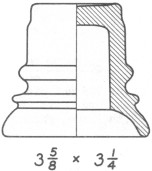Porcelain Insulator News
by Jack H. Tod, NIA #13
Reprinted from "INSULATORS - Crown Jewels of the Wire", May 1982, page 27
Dear Jack:
I thought you would be
interested in learning that I was fortunate in obtaining another specimen of the
"Henderson" insulator (reported in CJ 1975-1977 issues). A friend was
lucky enough to find this at the Lachute, Que. flea market, and which is in the
same town where the other specimen was found. I hastened to his place where we
made a deal so I could become the proud owner.

This specimen is essentially
identical to the other specimen I reported, being somewhat crudely turned and
having a greyish dark chocolate brown colour, although a bit darker than the
other one ....
Another interesting feature is that there are three marks in the
glaze on the dome, appearing as if they could have been made by the index and
middle fingers on one side and the thumb of the left hand on the other side, as
when handling the item during or after the glaze dipping process. These marks
are similar on both specimens, but they are much more pronounced on this second
specimen ....
Doug Henderson, NIA #593
Hawkesbury, Ont., Canada
- - - - - - - - - -
Very
interesting, and this is the first and only early "threadless" pin
type appearing in the Universal Style Chart of the new book "Worldwide
Porcelains". Doug's letter was full of very detailed info on background of
these insulators (too long to print in full), but he is continuing to try to
track down the origin of these items or learn of the early line on which they
were used in Ontario.
Jack

Dear Jack:
I bought this object (sketch above) at a
garage sale, and the man said he thought it was old and that it was an insulator
of some kind. It's crude ceramic, a light grey color and has no marking of any
kind. Any ideas what it was used for?
Dwight Dodge
Quesnel, B.C., Canada
- - - - - - - - - -
We'll
award one silver star to any reader who can identify this "whatisit"
thingamabob, and will make it a gold star if you can also show it's an insulator
and describe its use.
Jack
The Universal Style Chart of U.S. porcelains has
always been limited to unipart pin types, arbitrarily defined as those fired all
in one piece (thereby including glazewelded styles). This was strictly for
practicality, and I've been staunchly against varying from this ground rule,
although there are a number of small two-piece multis which are quite commonly
collected and mail traded.
But even without somewhat minor variations, we
already have over 950 styles in the chart. Certainly there are about that many
multipart cemented-together styles, and they all are larger styles ranging to
ship-anchor size. Discounting years of tine to research the catalogings of all
these, it would have taken thousands of hours to draw them all and publish them
in a book so big one couldn't lift it. And all for really no good purpose, since
the majority of these are either no longer extant, or are not collected, or
aren't ever mail traded, or discussed in correspondence, etc.
This arbitrary
rule has served us fairly well, but I've certainly lost a lot of sleep in the
past 11 years over the two items pictured below not being in the Universal Style
Chart. I'm thus repenting by adding these two classic Thomas transposition
insulators as U-219 and U-219A. I trust that this will be good news to the
fortunate several who may have one of these super goodies, and also to those
less fortunates who use the U- Chart as their Christmas "wish book"!
Both were cataloged by Thomas as their #2030, the U-219 in the 1907 catalog, the
U-219A in the 1912 catalog. Specimens exist of each style, but they are both in
the very rare class as far as I know. These are the only U.S. telephone styles
ever made by cemented parts. Canadian Porcelain Co. also made a very,
interesting two-piece cemented transposition, and it is included in the U-
Chart of "Worldwide Porcelains" for the same reason that it is a real
goody.
Jack
| 